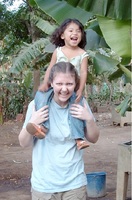Journey to Nicaragua
“And we, as part of the body of Christ, went to Nicaragua to meet another part of the body of Christ, so upon returning, we could share their story, understanding a little more, altering our lives so that we may live to honor their reality.” (Quotes from Chaplain’s Office 2001-2002)
Since 1999, the Chaplain’s Office has co-sponsored a reverse-mission experience called the Journey to Nicaragua. The Office assembles an “ecumenical team” of 10-12 students and 2-3 leaders to study, worship, retreat, and spend their spring break in Nicaragua.
The fall application process ensures that the group ranges in class years, denominational backgrounds, levels of Spanish fluency, experiences abroad, and a good male to female ratio. Once accepted, students are responsible for raising between $700-$1,000 to contribute to the cost of the trip. Whether they write letters, ask church members, friends, or parents, the students become integrally involved in supporting the cause of the trip.
Also during the fall, the team goes on a mid-semester retreat to begin grappling with the types of questions they will be answering over the next few months. The group continues to meet regularly in the spring to study the history, politics, economics, and theology of Nicaragua. They worship and study scripture and, according to the program website, “reflect on Christian discipleship and [their] roles as North American citizens.”
Chaplain Rob Spach believes the extensive preparation is essential to the unique nature of the program. In an interview, he said, “When we go to Nicaragua, a way of showing respect for our hosts is to know about their history, to know about the political circumstances that have shaped their lives, and how the U.S. fits into that.” Over spring break, the trip itinerary includes home-stays with Nicaraguan families, and visits to non-governmental agencies and places of worship.
[Image 2: David Baker ’11 with children at Pajaritos Azul, a home for disabled children in Mangua, 2008]
Spach considers the trip a type of civic engagement because it has a much broader spiritual and intellectual experience compared to typical styles of mission trips. Fashioned as a “reverse-mission,” the goal of the trip is not to evangelize or participate in service, but rather to learn and to share.
In a 2000 Davidsonian article, participant Grant Bleecher ’02 described the idea of reverse-mission. He said, “rather than go there and offer them ten days of our service, we spent ten days learning how to live an entire lifetime of awareness.”
The team goes to Nicaragua to experience life in that context, hoping to challenge, nurture, and transform their faith. Shaped by the journey, the team then returns to North America with a responsibility to communicate what they have learned with those around them.
Spach says that the team, in effect, becomes both “missionized by the people in Nicaragua and by each other” and “missionaries to our own culture.” Upon return to the United States, the group debriefs through a retreat and worship services. They also conduct presentations within the Davidson College and town communities to share their experiences.
Along with their stories, the students encourage others to take action by supporting fair-trade options where available or raising funds for non-profit organizations in Nicaragua.
[Image 3: Carolyn Klaasen ’09 and Angelica, 2007]
While the Journey to Nicaragua has created strong ties and relationships with the people in that country, the inaugural trip in 1998 was to El Salvador.
The trip destination had been chosen based on alumni connections in El Salvador but changed the following year because of another group visiting the organization. Spach and his co-sponsor subsequently chose Nicaragua after talking to a Spanish professor about CEPAD (hyperlink) (Council of Evangelical Churches of Nicaragua), an organization of over 50 evangelical churches in Nicaragua who work in development, emergency relief, and peacemaking.
Since that year, the Chaplain’s Office has co-sponsored the reverse mission experience to Nicaragua, working with CEPAD to plan and facilitate the ten day trip.
The other co-sponsor for the Journey to Nicaragua is Davidson College Presbyterian Church. The idea for the trip was initially brought to Spach by Andy Baxter, the Associate Pastor of Davidson United Methodist Church.
Inspired by a similar trip during his years at Duke University, Baxter approached Spach to ask for the college’s collaboration. After three years leading the trip, Baxter left DUMC in 2000. Spach then looked to DCPC as the new co-sponsor of the trip. Their Associate pastor, Kathy Beach-Verhey, led the trip with Spach the following year. Since then, DCPC has maintained its commitment to and support for the trip.
The Journey to Nicaragua experience continues to thrive and attract a competitive pool of applicants who are eager to take an alternative spring break and learn more about the global Christian community in South America.
Works Cited:
Quotes from Chaplain’s Office.RG 6/6.1 Chaplain, Nicaragua Trip 2001-2002.Davidson College Archives, Davidson, NC.
“Journey to Nicaragua.” Chaplain’s Office. Davidson College. <http://www3.davidson.edu/cms/x34369.xml>.
Bleecher, Grant. “Introspection in Nicaragua.” The Davidsonian. 13 April 2000.
“Chaplain’s Office’s Involvement with Service.” Interview by Ginny Evans and Allison Jones. March 2011. Davidson College Archives, Davidson, NC.
RG 6/6.1 Chaplain, Nicaragua Trip 2001-2002. Davidson College Archives, Davidson, NC.
CEPAD Brochure. RG 6/6.1 Chaplain’s Office, Spring Break Trip 2000. Davidson College Archives, Davidson, NC.
Author: Ginny Evans
Date: April 2011



